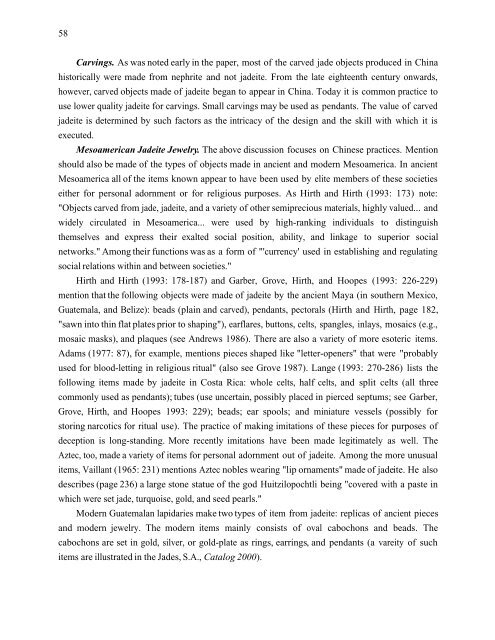JADEITE - Canadian Institute of Gemmology
JADEITE - Canadian Institute of Gemmology
JADEITE - Canadian Institute of Gemmology
You also want an ePaper? Increase the reach of your titles
YUMPU automatically turns print PDFs into web optimized ePapers that Google loves.
58<br />
Carvings. As was noted early in the paper, most <strong>of</strong> the carved jade objects produced in China<br />
historically were made from nephrite and not jadeite. From the late eighteenth century onwards,<br />
however, carved objects made <strong>of</strong> jadeite began to appear in China. Today it is common practice to<br />
use lower quality jadeite for carvings. Small carvings may be used as pendants. The value <strong>of</strong> carved<br />
jadeite is determined by such factors as the intricacy <strong>of</strong> the design and the skill with which it is<br />
executed.<br />
Mesoamerican Jadeite Jewelry. The above discussion focuses on Chinese practices. Mention<br />
should also be made <strong>of</strong> the types <strong>of</strong> objects made in ancient and modern Mesoamerica. In ancient<br />
Mesoamerica all <strong>of</strong> the items known appear to have been used by elite members <strong>of</strong> these societies<br />
either for personal adornment or for religious purposes. As Hirth and Hirth (1993: 173) note:<br />
"Objects carved from jade, jadeite, and a variety <strong>of</strong> other semiprecious materials, highly valued... and<br />
widely circulated in Mesoamerica... were used by high-ranking individuals to distinguish<br />
themselves and express their exalted social position, ability, and linkage to superior social<br />
networks." Among their functions was as a form <strong>of</strong> "'currency' used in establishing and regulating<br />
social relations within and between societies."<br />
Hirth and Hirth (1993: 178-187) and Garber, Grove, Hirth, and Hoopes (1993: 226-229)<br />
mention that the following objects were made <strong>of</strong> jadeite by the ancient Maya (in southern Mexico,<br />
Guatemala, and Belize): beads (plain and carved), pendants, pectorals (Hirth and Hirth, page 182,<br />
"sawn into thin flat plates prior to shaping"), earflares, buttons, celts, spangles, inlays, mosaics (e.g.,<br />
mosaic masks), and plaques (see Andrews 1986). There are also a variety <strong>of</strong> more esoteric items.<br />
Adams (1977: 87), for example, mentions pieces shaped like "letter-openers" that were "probably<br />
used for blood-letting in religious ritual" (also see Grove 1987). Lange (1993: 270-286) lists the<br />
following items made by jadeite in Costa Rica: whole celts, half celts, and split celts (all three<br />
commonly used as pendants); tubes (use uncertain, possibly placed in pierced septums; see Garber,<br />
Grove, Hirth, and Hoopes 1993: 229); beads; ear spools; and miniature vessels (possibly for<br />
storing narcotics for ritual use). The practice <strong>of</strong> making imitations <strong>of</strong> these pieces for purposes <strong>of</strong><br />
deception is long-standing. More recently imitations have been made legitimately as well. The<br />
Aztec, too, made a variety <strong>of</strong> items for personal adornment out <strong>of</strong> jadeite. Among the more unusual<br />
items, Vaillant (1965: 231) mentions Aztec nobles wearing "lip ornaments" made <strong>of</strong> jadeite. He also<br />
describes (page 236) a large stone statue <strong>of</strong> the god Huitzilopochtli being "covered with a paste in<br />
which were set jade, turquoise, gold, and seed pearls."<br />
Modern Guatemalan lapidaries make two types <strong>of</strong> item from jadeite: replicas <strong>of</strong> ancient pieces<br />
and modern jewelry. The modern items mainly consists <strong>of</strong> oval cabochons and beads. The<br />
cabochons are set in gold, silver, or gold-plate as rings, earrings, and pendants (a vareity <strong>of</strong> such<br />
items are illustrated in the Jades, S.A., Catalog 2000).









